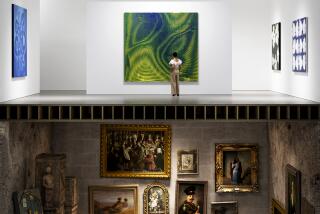The Lion Will Roar at LACMA : Movies: Marking MGM’s 70th anniversary year, a prime batch of the studio’s films will screen in a two-month, 40-film tribute starting Friday.
- Share via
Like the remains of some dethroned colossus, the disparate components of Metro-Goldwyn-Mayer, once the studio of studios, lie scattered and apart, an almost biblical rebuke to the hubris of those who felt they had created an invincible movie-making machine that could last forever.
The fabled MGM lot in Culver City, which once spread over 275 acres and boasted a lake, a jungle and its own post office, is now reduced in size and in the hands of the Sony Corp., which is carefully restoring it to previous splendor.
The movies MGM made in its glory days, well over a thousand all told, are now owned by the Atlanta-based Turner Entertainment Co., which is about to put them into service as the centerpiece of a new, commercial-free movie channel to be called TCM (for Turner Classic Movies, of course) and set to begin broadcasting in April.
*
And, after depressing years in an office building just across the street from its old home, the movie-making part of MGM has relocated in a development in Santa Monica and is trying hard--witness its current “Six Degrees of Separation”--to claim a spot as a studio to be reckoned with.
For those who long for the old days, when the studio’s credo was “Make it good . . . make it big . . . give it class,” there is a temporary reprieve. Starting Friday (and marking the studio’s 70th anniversary year), the Los Angeles County Museum of Art is hosting a two-month, 40-film tribute, complete with star appearances, to the entire span of MGM, from early silents like 1924’s “He Who Gets Slapped” to its more recent triumphs like “Moonstruck” and “Thelma & Louise.”
In an age when, unlike today, studios were not owned by diversified conglomerates and so had the opportunity to develop distinctive personalities, several things marked MGM and made it stand out from the pack.
First was the studio’s insistence on quality. From top people like art director Cedric Gibbons and costumer Adrian down to the merest grip, MGM’s employees believed in making the glossiest, most glamorous films possible, and often stayed around for decades in order to make that happen.
*
And what better to achieve glamour than stars? Other studios might have the better directors or sharper writers, but not for nothing was MGM’s motto “More Stars Than There Are in Heaven.” The studio scoured the Earth for likely performers, and when if it felt the potential was there, as it it did with a beautiful but untutored 18-year-old Ava Gardner, it did not hesitate to bring a neophyte out to the studio for a complete and total make-over, including voice, posture, dress and deportment.
Overseeing all this was the man without whom MGM would have been a very different place, Louis B. Mayer, who ran the studio like a benevolent/authoritarian father with a large and unruly family. Working out of an office so sizable that fellow mogul Samuel Goldwyn claimed “you need an automobile just to reach your desk,” Mayer often out-acted his stars as he threatened or cajoled them into doing things his way. A major league sentimentalist who claimed to worship women, especially mothers, his fondness for make-believe emotions and real tears marked MGM’s product as surely as the roar of Leo the Lion that proceeded each film.
*
The museum’s selection from MGM’s vast output has, of course, its share of familiar classics that are always welcome on the big screen, from star vehicles like “The Philadelphia Story,” “Mrs. Miniver” and “Dinner at Eight” to familiar and deservedly loved musicals like “Singin’ in the Rain” and “The Wizard of Oz.”
The museum is also showing once-celebrated films not often thought of anymore. For instance, the severely truncated (by head of production Irving Thalberg) version of Erich Von Stroheim’s would-be masterpiece “Greed,” accompanied, as are all the silent films, by the excellent Robert Israel at the organ. Or the wildly popular weepy “Random Harvest,” a preposterous but irresistible tale of love and amnesia featuring classy performances by Greer Garson and Ronald Coleman.
Best of all, the series offers a chance for more in-depth looks at three areas the studio had something of a reputation in, starting with that most MGM of genres, the musical. The most celebrated were made by the Arthur Freed Unit, and the museum is screening some of these as well as some non-Freed extravaganzas. For instance:
“The Harvey Girls”: Though she overmatches her nominal romantic co-star, John Hodiak, Judy Garland is expressive as always in this George Sidney-directed extravaganza about restaurant chain waitresses who helped conquer the West “with a beefsteak and a cup of coffee.” Also memorable in this beautiful new print are Angela Lansbury as a bar-hall soprano with a permanent smirk, the tap-dancing of Ray Bolger, and the classic showstopper, “On the Atchison, Topeka and the Santa Fe,” which took 20 days to rehearse and eight hours to film.
“Lili”: Any musical in which Zsa Zsa Gabor gives one of the stronger performances has got to be unusual, but the truth is that with one exception all the acting in this film is undistinguished. That exception is the luminous Leslie Caron, whose enchanting performance as an innocent young waif who communicates with marionettes helped, along with the lilting “Hi-Lili-Hi-Lo,” to make this a perennial audience favorite.
“Seven Brides for Seven Brothers”: If the musical is one of the most American of genres, this has got to be one of the most American of musicals. Set in the Oregon Territory in 1850 and starring Jane Powell as the intrepid woman who impulsively marries Howard Keel only to find he lives with six unruly brothers, this film is known for its revolutionary Michael Kidd choreography. Brawny and athletic, “Brothers” featured dances that are half brawls and brawls that are half dances. It’s as energetic and lively a musical as any studio ever made.
Although MGM isn’t always remembered for its horror films, it made more than its share, some of which are featured in a five-film Horror Movie Marathon. Perhaps the most unusual of these is “Mad Love,” an atmospheric curio starring Peter Lorre as a brilliant but obsessed surgeon who grafts a killer’s hands onto a concert pianist and lives to regret it. Aside from hearing Lorre say lines like “I, a poor peasant, have conquered science; why can’t I conquer love?” the main interest this uneven film provides is its Expressionistic look and the work of Gregg Toland.
MGM was also the home of perhaps the most unsettling actors Hollywood ever produced, Lon Chaney, and this series features three of his films, starting with “He Who Gets Slapped” and ending with Chaney’s only talkie, a remake of his earlier success, “The Unholy Three,” which was released only seven weeks before the actor’s untimely death at age 47.
With his expressive eyes and a mobile face, Chaney’s greatest characterizations mixed pathos with malignancy to extraordinary effect. “The Unknown,” directed by longtime collaborator Tod Browning in 1927, is vintage Chaney. He plays Alonzo the Armless, a traveling performer who competes with the circus strongman for the affection of the sloe-eyed Nanon (an early role for Joan Crawford). Chaney used a double for some of the armless situations, but the formidable and unsettling presence he brought to the role is his alone.
More characteristic of the studio, and also represented by a marathon, are family films, the warm-hearted sentimental stuff that L.B. loved so well. In addition to “Captains Courageous” and a pair of Garland/Mickey Rooney programmers (including “Love Finds Andy Hardy,” one of 16 Hardy films the studio turned out), the museum is showing one of the best-loved kids movies ever made, “Lassie Come Home.”
According to a fascinating book on the Lassie phenomenon by Ace Collins, MGM auditioned no fewer than 1,500 dogs when it decided to film the popular Eric Knight novel. Pal, the male dog who ended up playing Lassie on film, was originally hired as a stand-in, but when the nominal star refused to do a demanding sequence, Pal (quite literally) jumped in, and the rest is history.
Finely assisted by Roddy McDowall and an 11-year-old Elizabeth Taylor in her first MGM role, “Lassie Come Home” earned $3 million in its opening weekend, a phenomenal figure for 1943. As this entertaining series constantly reminds us, making family fare with integrity as well as emotion has become as much of a lost art as all the other things MGM did so well, things that no one else seems to do at all these days.
The Dates and Times
The schedule for the MGM series at LACMA is:
Friday at 1 p.m. and 8 p.m.: “He Who Gets Slapped,” “The Harvey Girls.” Appearances by George Sidney, Virginia O’Brien.
Saturday at 8 p.m.: “Greed,” “The Unholy Three.”
Jan. 14 at 1 p.m. and 8 p.m.: “Mogambo,” “Tarzan the Ape Man.”
Jan. 15 at 10 a.m.: “Love Finds Andy Hardy,” “Lassie Come Home,” “Captains Courageous,” “Strike Up the Band.”
Jan. 21 at 1 p.m.: “The Broadway Melody,” “Maytime,” “Ziegfeld Follies,” “The Wizard of Oz,” “Good News.” Appearances by Anita Page, Jerry Maren, Aljean Harmetz, Mel Torme.
Jan. 22 at 8 p.m.: “Show Boat,” “Seven Brides for Seven Brothers.” Appearances by George Sidney, Kathryn Grayson, Russ Tamblyn.
Jan. 28 at 1 p.m. and 8 p.m.: “Singin’ in the Rain,” “Brigadoon.” Appearance by Kathleen Freeman.
Jan. 29 at 8 p.m.: “Lili,” “The Barclays of Broadway.”
Feb. 4 at 1 p.m.: “The Mask of Fu Manchu,” “Mad Love,” “Mark of the Vampire,” “The Devil Doll,” “The Picture of Dorian Gray.”
Feb. 5 at 8 p.m.: “The Unknown,” “Dr. Jekyll and Mr. Hyde.”
Feb. 11 at 1 p.m. and 8 p.m.: “Random Harvest,” “Father of the Bride.” Appearance by Don Taylor.
Feb. 12 at 8 p.m.: “Mrs. Miniver,” “Dinner at Eight.”
Feb. 18 at 1 p.m. and 8 p.m.: “Gaslight,” “Boom Town.”
Feb. 19 at 8 p.m.: “The Philadelphia Story,” “Bells Are Ringing.”
Feb. 25 at 1 p.m. and 8 p.m.: “Of Mice and Men,” “The Man in the Moon.”
Feb. 26 at 8 p.m.: “Thelma & Louise,” “Moonstruck.”
The Leo S. Bing Theater is at the Los Angeles County Museum of Art, 5905 Wilshire Blvd.
Admission is $6 general, $4 for members, AFI members, seniors and students.
Tickets can be purchased either at the box office or through Ticketmaster.
For more information: (213) 857-6010.
More to Read
Only good movies
Get the Indie Focus newsletter, Mark Olsen's weekly guide to the world of cinema.
You may occasionally receive promotional content from the Los Angeles Times.











